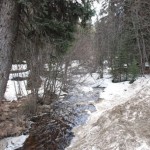Despite several heavy snowfalls, water basin levels in the Okanagan and Similkameen remain slightly below normal.
Kate Thompson, media relations manager for the Ministry of Environment, says between November and December, temperatures fluctuated from two and three degrees higher than usual to three to five degrees below the norm.
“During the last 10 days of 2008, the sustained cold brought substantial snow accumulations at sea level on Vancouver Island and the South Coast, and contributed to significant valley-bottom accumulations throughout the Interior,” says Thompson.
She says following the cold December, an intense warm and wet frontal storm hit the South Coast, bringing two days of heavy rain and flooding to parts of Vancouver Island, Metro Vancouver and the Fraser Valley.
“This resulted in very large accumulations of snow in the mountainous areas of the South Coast and brought heavy snow to the South Interior. Snow packs on the South Coast that were near record low levels on January 5 increased dramatically by January 8.”
Thompson says due to the January 6-8 snowstorms, snow conditions have changed significantly since the provincial snow survey conducted around January 1.
“As of January 9, the northern half of the province, including the Skeena, Nass, Peace, Liard and Stikine basins, has above normal snow packs. The Upper Fraser, Nechako and Thompson basins are all near normal. The Kootenay, Columbia, Okanagan, Kettle and Similkameen basins received very heavy snow falls on January 6-8, but remain slightly below normal.”
She says in terms of water supply outlook for the year, nearly half the yearly snow pack has accumulated.
“The near or above normal snow accumulation in many areas provides a favourable outlook for spring and summer stream flow and water supply. Below normal snow conditions on Vancouver Island and the South Coast may result in below normal stream flow and water supply in those areas this summer if low snow pack conditions continue.”

